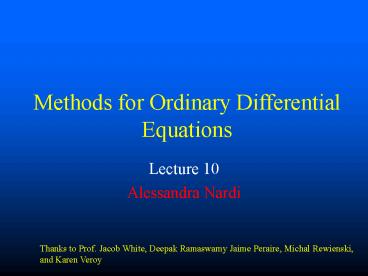Methods for Ordinary Differential Equations - PowerPoint PPT Presentation
1 / 38
Title:
Methods for Ordinary Differential Equations
Description:
Also, for sake of simplicity only consider. linear case: ... Two types of error ... Not enough to look at LTE, in fact: ... – PowerPoint PPT presentation
Number of Views:43
Avg rating:3.0/5.0
Title: Methods for Ordinary Differential Equations
1
Methods for Ordinary Differential Equations
Lecture 10 Alessandra Nardi
Thanks to Prof. Jacob White, Deepak Ramaswamy
Jaime Peraire, Michal Rewienski, and Karen Veroy
2
Outline
- Transient Analysis of dynamical circuits
- i.e., circuits containing C and/or L
- Examples
- Solution of Ordinary Differential Equations
(Initial Value Problems IVP) - Forward Euler (FE), Backward Euler (BE) and
Trapezoidal Rule (TR) - Multistep methods
- Convergence
3
Application ProblemsSignal Transmission in an
Integrated Circuit
Signal Wire
Wire has resistance
Wire and ground plane form a capacitor
Logic Gate
Logic Gate
Ground Plane
- Metal Wires carry signals from gate to gate.
- How long is the signal delayed?
4
Application ProblemsSignal Transmission in an IC
Circuit Model
Constructing the Model
- Cut the wire into sections.
- Model wire resistance with resistors.
- Model wire-plane capacitance with capacitors.
5
Application ProblemsSignal Transmission in an IC
2x2 example
Constitutive Equations
Conservation Laws
R2
R1
C1
R3
C2
Nodal Equations Yields 2x2 System
6
Application ProblemsSignal Transmission in an IC
2x2 example
Eigenvalues and Eigenvectors
7
An Aside on Eigenanalysis
Eigendecomposition
8
An Aside on Eigenanalysis
Decoupled Equations!
9
Application ProblemsSignal Transmission in an IC
2x2 example
Notice two time scale behavior
- v1 and v2 come together quickly (fast
eigenmode). - v1 and v2 decay to zero slowly (slow eigenmode).
10
Circuit Equation Formulation
- For dynamical circuits the Sparse Tableau
equations can be written compactly - For sake of simplicity, we shall discuss first
order ODEs in the form
11
Ordinary Differential EquationsInitial Value
Problems (IVP)
- Typically analytic solutions are not available
- ? solve it numerically
12
Ordinary Differential Equations Assumptions and
Simplifications
- Not necessarily a solution exists and is unique
for - It turns out that, under rather mild conditions
on the continuity and differentiability of F, it
can be proven that there exists a unique
solution. - Also, for sake of simplicity only consider
- linear case
We shall assume that
has a unique solution
13
Finite Difference MethodsBasic Concepts
First - Discretize Time
Second - Represent x(t) using values at ti
14
Finite Difference Methods Forward Euler
Approximation
15
Finite Difference Methods Forward Euler Algorithm
16
Finite Difference Methods Backward Euler
Approximation
17
Finite Difference Methods Backward Euler
Algorithm
18
Finite Difference Methods Trapezoidal Rule
Approximation
19
Finite Difference Methods Trapezoidal Rule
Algorithm
Solve with Gaussian Elimination
20
Finite Difference Methods Numerical Integration
View
21
Finite Difference Methods Summary of Basic
Concepts
Trap Rule, Forward-Euler, Backward-Euler
Are all one-step methods Forward-Euler is
simplest No equation solution
explicit method. Boxcar approximation to
integral Backward-Euler is more expensive
Equation solution each step implicit
method Trapezoidal Rule might be more accurate
Equation solution each step implicit
method Trapezoidal approximation to
integral
22
Multistep Methods Basic Equations
Nonlinear Differential Equation
k-Step Multistep Approach
23
Multistep Methods Common AlgorithmsTR, BE, FE
are one-step methods
Multistep Equation
24
Multistep Methods Definition and Observations
Multistep Equation
How does one pick good coefficients?
Want the highest accuracy
25
Multistep Methods Convergence Analysis
Convergence Definition
Definition A finite-difference method for
solving initial value problems on 0,T is said
to be convergent if given any A and any initial
condition
26
Multistep Methods Convergence Analysis Order-p
Convergence
Definition A multi-step method for solving
initial value problems on 0,T is said to be
order p convergent if given any A and any initial
condition
Forward- and Backward-Euler are order 1 convergent
Trapezoidal Rule is order 2 convergent
27
Multistep Methods Convergence Analysis Two
types of error
28
Multistep Methods Convergence Analysis Two
conditions for Convergence
- For convergence we need to look at max error over
the whole time interval 0,T - We look at GTE
- Not enough to look at LTE, in fact
- As I take smaller and smaller timesteps Dt, I
would like my solution to approach exact solution
better and better over the whole time interval,
even though I have to add up LTE from more
timesteps.
29
Multistep Methods Convergence Analysis Two
conditions for Convergence
1) Local Condition One step errors are small
(consistency)
Typically verified using Taylor Series
2) Global Condition The single step errors do
not grow too quickly (stability)
All one-step methods are stable in this sense.
30
One-step Methods Convergence Analysis
Consistency definition
Definition A one-step method for solving initial
value problems on an interval 0,T is said to
be consistent if for any A and any initial
condition
31
One-step Methods Convergence Analysis
Consistency for Forward Euler
Proves the theorem if derivatives of x are bounded
32
One-step Methods Convergence Analysis
Convergence Analysis for Forward Euler
33
One-step Methods Convergence Analysis
Convergence Analysis for Forward Euler
34
One-step Methods Convergence Analysis A
helpful bound on difference equations
35
One-step Methods Convergence Analysis A
helpful bound on difference equations
36
One-step Methods Convergence Analysis Back to
Convergence Analysis for Forward Euler
37
One-step Methods Convergence Analysis
Observations about Convergence Analysis for FE
- Forward-Euler is order 1 convergent
- The bound grows exponentially with time interval
- C is related to the solution second derivative
- The bound grows exponentially fast with norm(A).
38
Summary
- Transient Analysis of dynamical circuits
- i.e., circuits containing C and/or L
- Examples
- Solution of Ordinary Differential Equations
(Initial Value Problems IVP) - Forward Euler (FE), Backward Euler (BE) and
Trapezoidal Rule (TR) - Multistep methods
- Convergence































